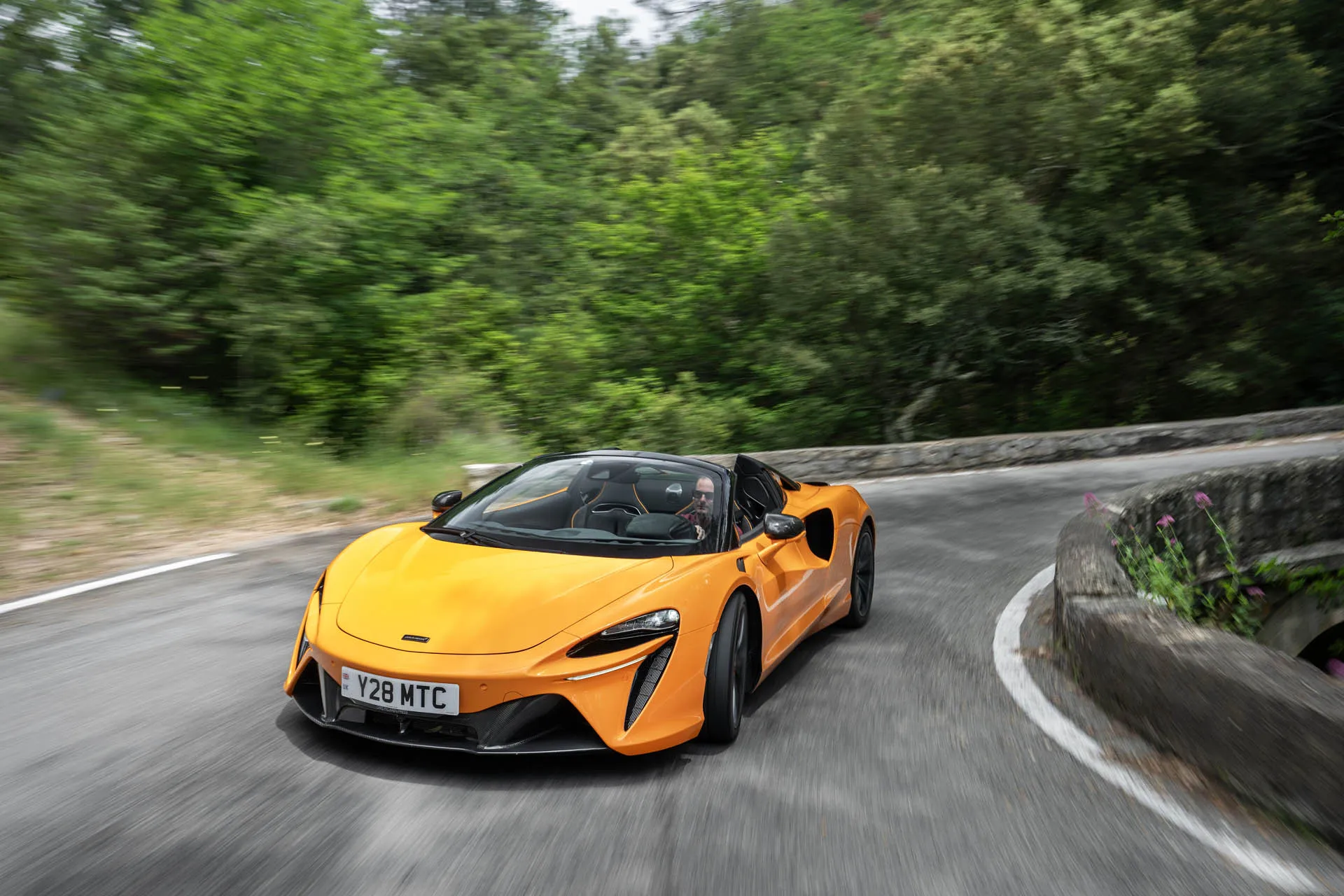-
The McLaren Artura Spider brings a raft of enhancements to the lineup for 2025
-
The 2025 Artura Spider costs $24,700 more than the coupe
-
McLaren used its race-car knowledge to create a compelling plug-in hybrid supercar
Just 48 hours ago Lando Norris skirted in front of George Russell and Max Verstappen in front of my very own eyes at the 2024 Montreal F1 Grand Prix. Lando didn’t win, but took P2 after a wet and wild race.
Now I find myself behind the wheel of the 2025 McLaren Artura Spider. The two events aren’t related, but I realize Norris’ car in some ways has a trickle down effect on what I’m experiencing. This company builds street cars and race cars, and I can feel the race car in this amazing street machine.
When the 2025 McLaren Artura Spider arrives in the U.S. later this summer it’ll plug into the coupe’s fun but up the ante by going topless and incorporating a spate of enhancements for the whole Artura lineup.
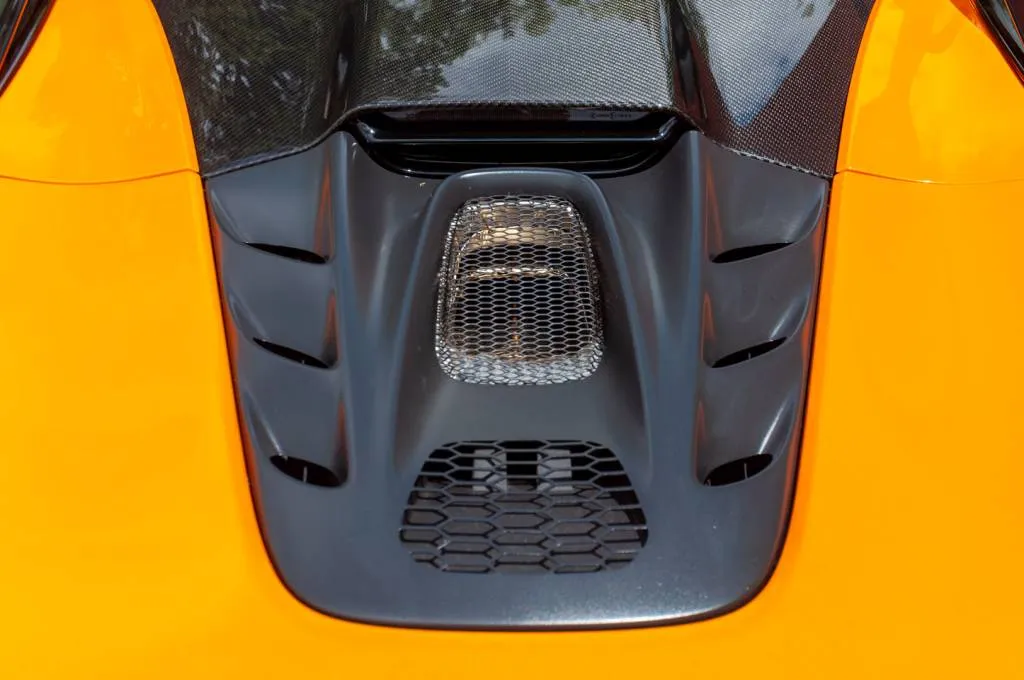
2025 McLaren Artura Spider
Artura Spider and coupe get more power and new tricks
The Artura Spider uses the coupe’s 120-degree twin-turbo 3.0-liter V-6 that mates to a 94-hp axial-flux motor sandwiched in the 8-speed dual-clutch gearbox, but it now has more power. Total system output has risen 19 hp to 690 hp and 531 lb-ft of torque, and there are new engine mounts for smoother power transitions. Don’t worry coupe owners because McLaren has your back. You can have your cars reflashed to get the extra 19 hp, and it won’t even cost a dime, but new engine mounts are out of the question.
The extra motivation comes with a revised power curve that adds a crescendo to the 4,000-5,000-rpm rev range. The 8-speed dual-clutch gearbox’s pre-fill gear shifts are now up to 25% quicker because the open clutch is pulled closer to the kissing point for smaller movements during shifts.
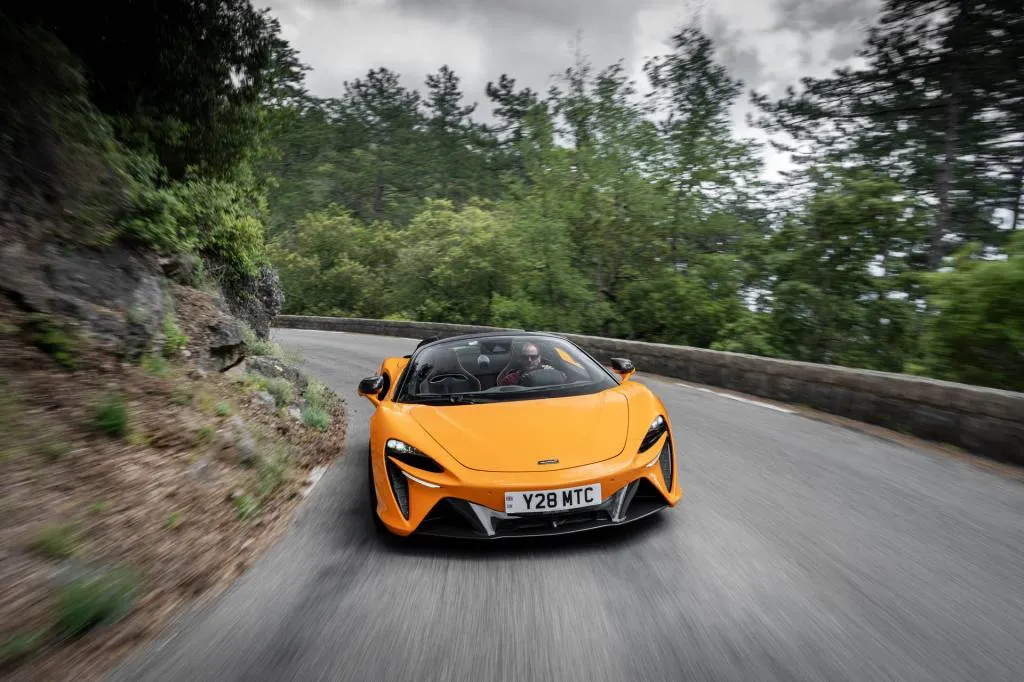
2025 McLaren Artura Spider
Spider buyers don’t give up an inch of straight-line performance by opting to go without a fixed roof. McLaren said the Artura Spider does 0-60 mph in 3.0 seconds, 0-124 mph in 8.4 seconds, the quarter mile in 10.8 seconds, and can hit an electronically limited 205 mph. These are the same specs as the coupe.
What’s wild is the Spider weighs 3,439 pounds, which is only 136 pounds more than the coupe. A Maserati MC20 Cielo weighs only 44 pounds less, and it isn’t a plug-in hybrid.
The McLaren team seems extra proud of a new Spinning Wheel Pull-Away feature that is essentially a burnout mode. It joins a launch control function but does the opposite thing. I don’t want to go to jail, so burnout mode will not be engaged today because I’m driving on public roads around Monaco and Nice, France. For those who haven’t been here, these roads are tight, narrow, and full of traffic.
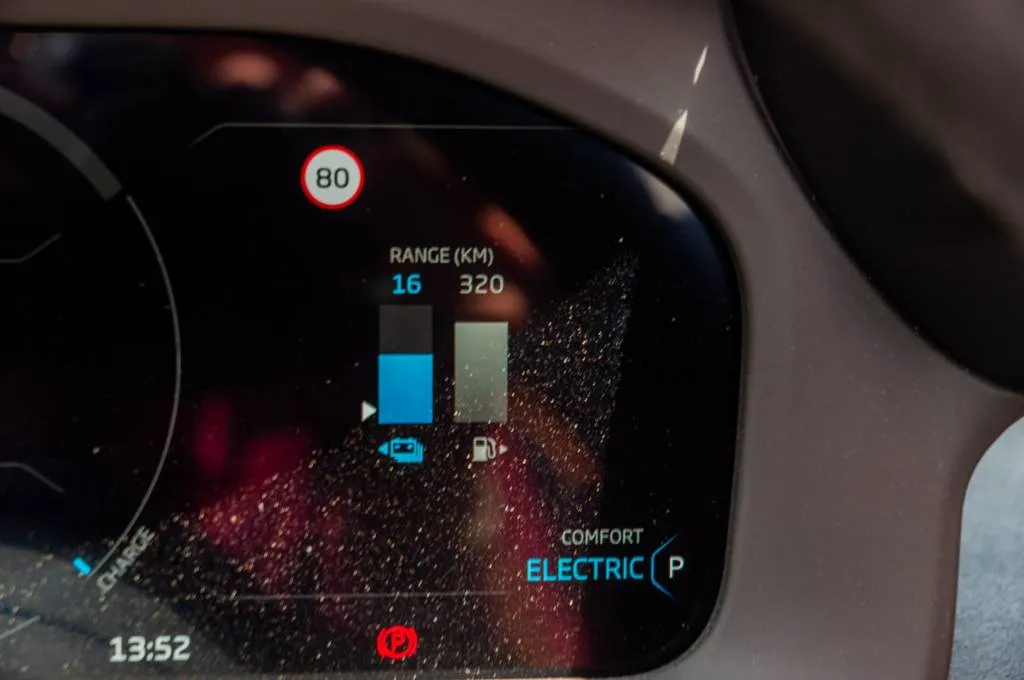
2025 McLaren Artura Spider
Artura Spider can be silent or loud, driver’s choice
As I toggle the gear selector button into drive on the carbon-fiber center console all I hear is a click. It’s the transmission engaging, but the engine doesn’t fire to life. I have the car in Comfort mode, but the 7.4-kwh battery pack is juiced and providing the power. The hard top, with its optional $9,400 electrochromic option, is down. It’s only about 60 degrees and the sun’s just coming out of the clouds.
As I pull out of the hotel parking lot the engine is still off. It’s weird to drive a Papaya Orange McLaren supercar in silence. I soon come to a roundabout and the turbocharged V-6 fires to life. But I’m on slow city streets, so I toggle the drive mode selector on the top right of the gauge cluster binnacle to Electric mode. The engine shuts down.
Silence again. Matting the accelerator pedal to the floor moves the McLaren forward, but not with urgency. Suddenly it’s a 94-hp electric car, which isn’t much power. The engine is locked out until either the battery’s juice runs too low or I toggle back to Comfort, Sport, or Track mode. But there’s enough power here to drive at city speeds. The battery is good for about 11 miles of electric-only driving, takes about 2.5-hours to charge on a Level 2 240-volt charger, and needs about 7 hours to charge on a Level 1 110-volt charger. McLaren says the Artura can go up to 80 mph in electric only mode, but with only 94 hp I don’t bother trying.
The system can be locked to Max battery state by pulling a little stalk on the left side of the steering column. This will hold the battery’s charge so the Artura could drive to a city center and ensure there’s a full battery. It can also force the gas engine to act as a generator to recharge the battery on the move, though that’s not an efficient way of doing things. Then again, this is a supercar, so who cares about efficiency? Fuel economy ratings check in at 19 mpg combined, which is actually efficient for a supercar.
As I increase momentum there’s suddenly noise, but it’s not from the engine. The sounds are coming from the dual-clutch transmission as it shifts through its gears, despite the engine being off. It’s a very mechanical sound as clutch packs move and engage. I can also hear the hydraulic power steering pump, which engages each time I move the steering wheel. None of this is annoying, just present. But enough dawdling. Time to rip.

2025 McLaren Artura Spider
Arturas are now louder than before
Toggling the drive mode selector to Comfort the engine quickly fires to life. The noise is back, and it’s good: deep, guttural, and so much better than a V-6 usually sounds. Pulling onto the highway with a gaggle of blue and orange Artura Spiders—yeah, we’re real nondescript—I flick the drive mode selector to Sport and we all move to the left lane. Pedal down and whoosh. A symphony of noise blasts into the atmosphere.
McLaren redesigned the Artura’s exhaust for the Spider, and the coupe’s getting this new system as well. New resonator tuning and tailpipe design featuring upward conical shapes increase exhaust flow and reduce resonance. McLaren also uses new active valves both on the standard car and my car’s $5,100 sport exhaust system. Opting for the sport exhaust adds a symposer, which pipes the real exhaust noise into the cabin. McLaren says it spits out 20% more noise. It’s noticeable.
Whereas Comfort mode upshifts quickly, downshifts late, maintains low revs, and keeps the active exhaust valves mostly closed, Sport mode does the opposite in all ways. Shifts are quicker, the revs stay higher, and the valves in the exhaust open. We approach a tunnel, and you can guess what comes next.
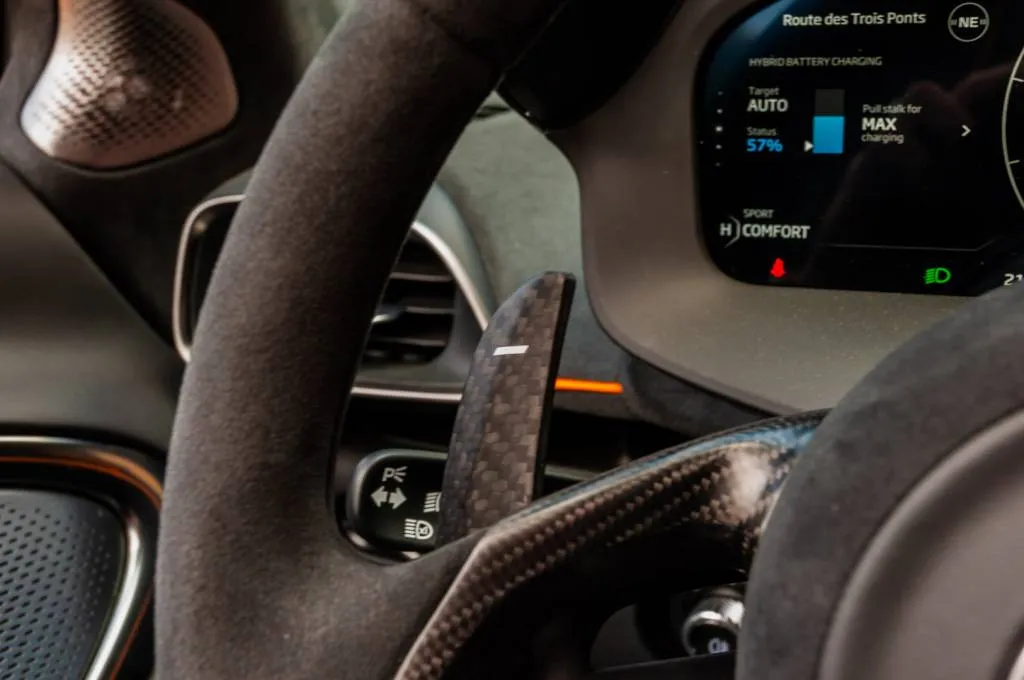
2025 McLaren Artura Spider
I click the left steering wheel-mounted carbon-fiber shift paddle to induce rapid gear changes from fourth to second. The resulting noise bouncing off the tunnel walls should be bottled and sold in stores. There’s a hint of Porsche flat-6 here, but it’s deeper, and not as nasal.
The noise is mechanical as well. I hear the Artura Spider’s powertrain winding up and down ahead of me as we slice and dice through corners throughout the morning. The turbos spooling and winding down sound like mini turbines.
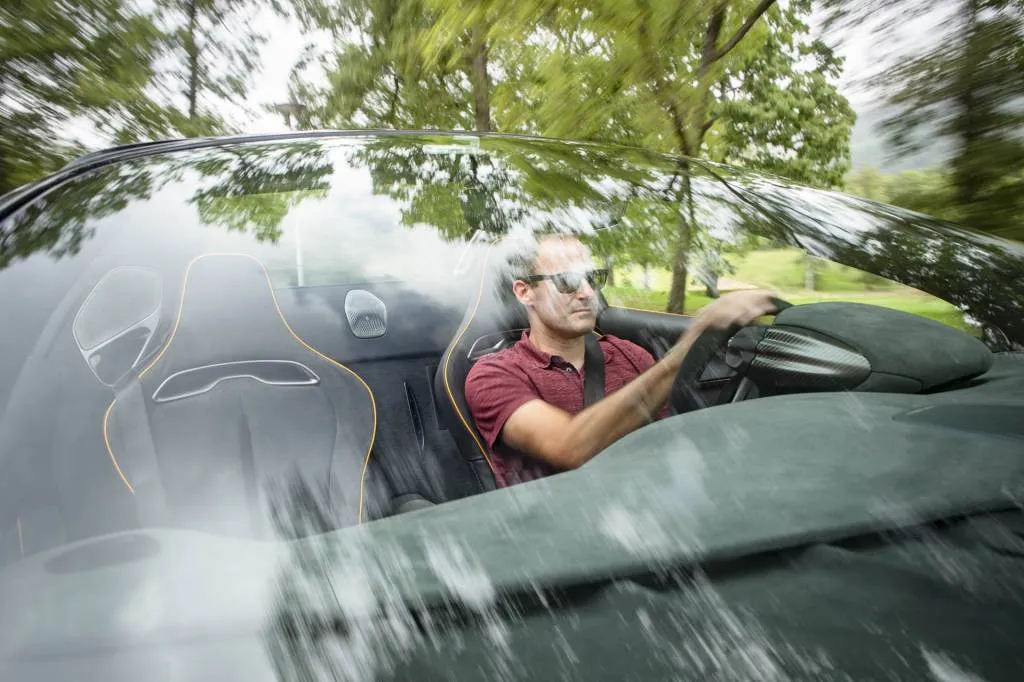
2025 McLaren Artura Spider
Arturas Spider handles like the coupe
Sweeping right off the highway I stick with another Papaya Orange Artura Spider and we start tearing around backcountry roads at completely sane and moderate speeds. The grip from the staggered Pirelli P Zero 235/35R19 front and 295/35R20 rear tires provides limits beyond what anyone should test on the street. Our cars have these tires, but optional P Zero Corsas can be had for those seeking track days. Those are basically street-legal race slicks.
A left toggle on the top of the gauge cluster binnacle rotates through the Comfort, Sport, and Track suspension modes. The controllers for the system have been upgraded so changes now occur 90% quicker than before. Comfort is best on the road. The adjustable dampers make the ride compliant and comfortable enough for a road trip, but it’s still quick and responsive around corners. The pavement here is far from new and undulates so much that in Sport mode it feels as if things will get skittish at these speeds. Track mode is simply too firm for the road. It’s not shake-your-kidneys violent like a Hyundai Veloster N can be, but it’s unreasonable and meant for the track or the smoothest of pavement. I have access to neither of those today.
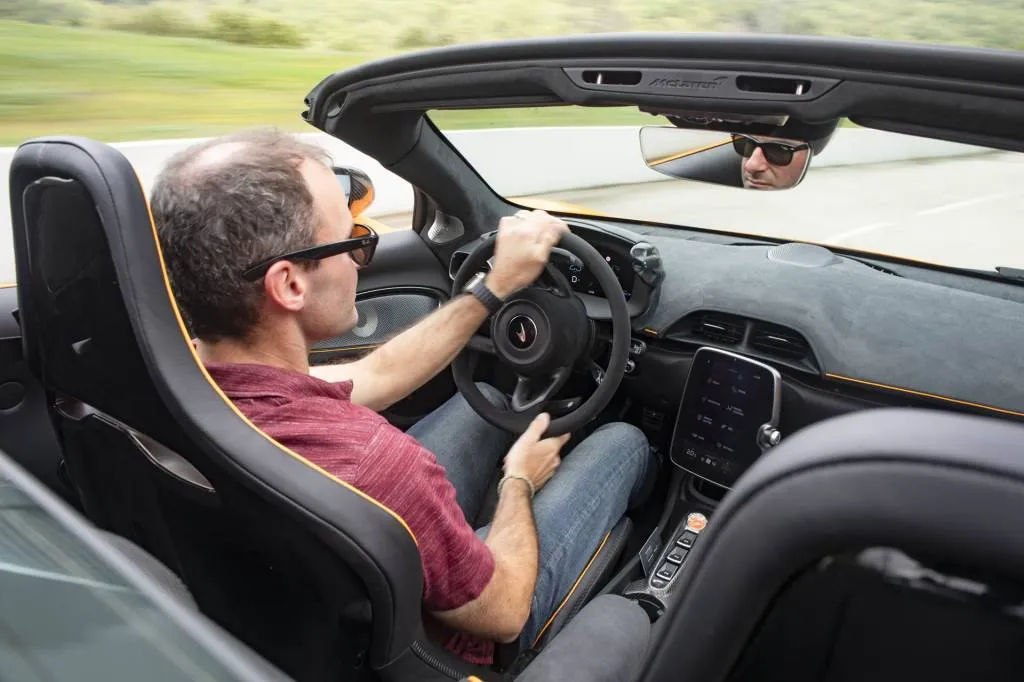
2025 McLaren Artura Spider
The steering is sublime through all of this, and is perhaps the true highlight of the car. In an era of overboosted and electronically controlled steering systems, McLaren’s given us an electro-hydraulic unit that has no variable assist and no variable ratio nonsense. It’s just brilliantly weighted, not too heavy in parking lots, and not too light while slicing and dicing through France’s country roads. I can feel the pebbles the Pirellis are picking up through the steering wheel.
The pizza-sized carbon-ceramic brake discs are fling-you-forward-in-your-seat strong. Senior Editor Kirk Bell got these things to smoke on the racetrack in the coupe, but since then McLaren has revised the brake cooling ducts to improve airflow. I’m cooking pretty good, which may or may not require quickly shedding speed as I approach multiple corners. No smoke. No smell. No fade. The brakes are just strong, progressive, and completely free of a blend with regenerative braking. No energy is getting put back into the battery pack because McLaren wanted a natural feel, which it delivered.
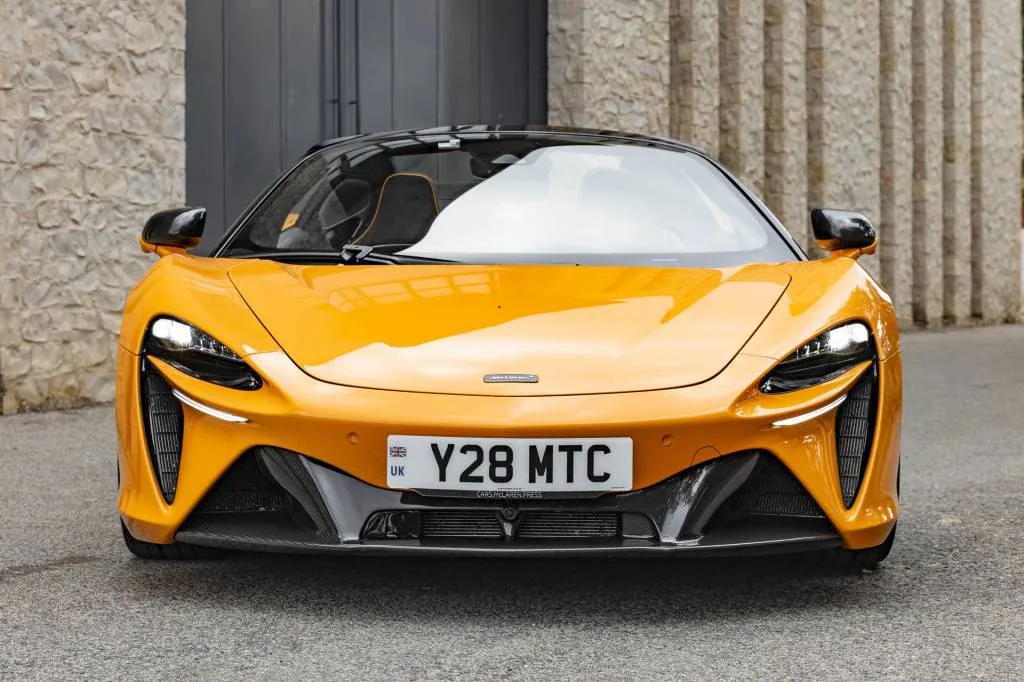
2025 McLaren Artura Spider
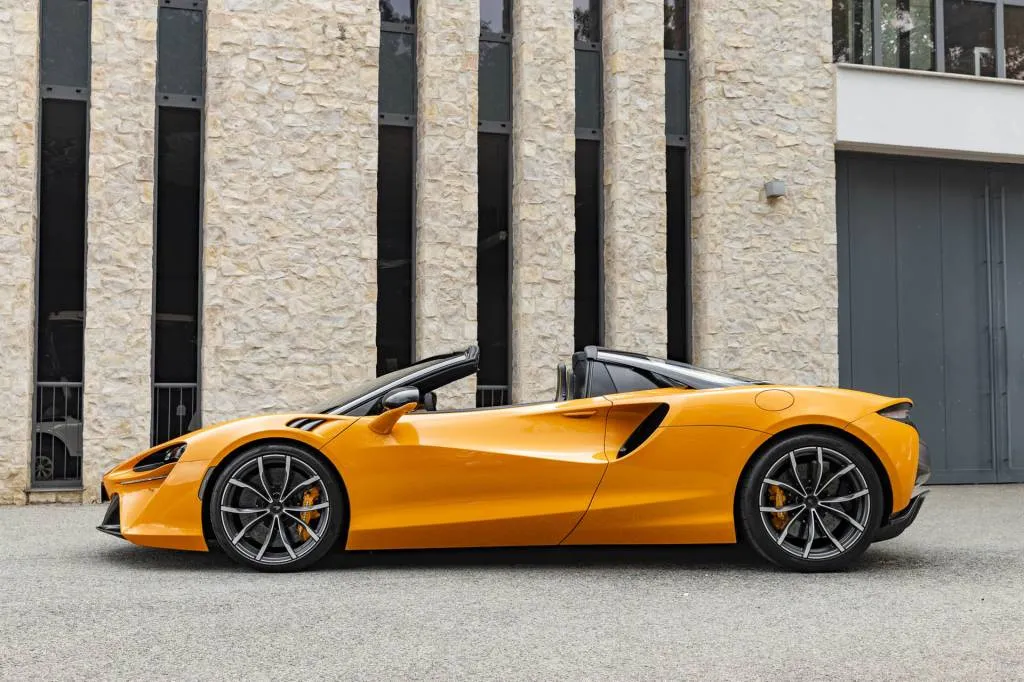
2025 McLaren Artura Spider
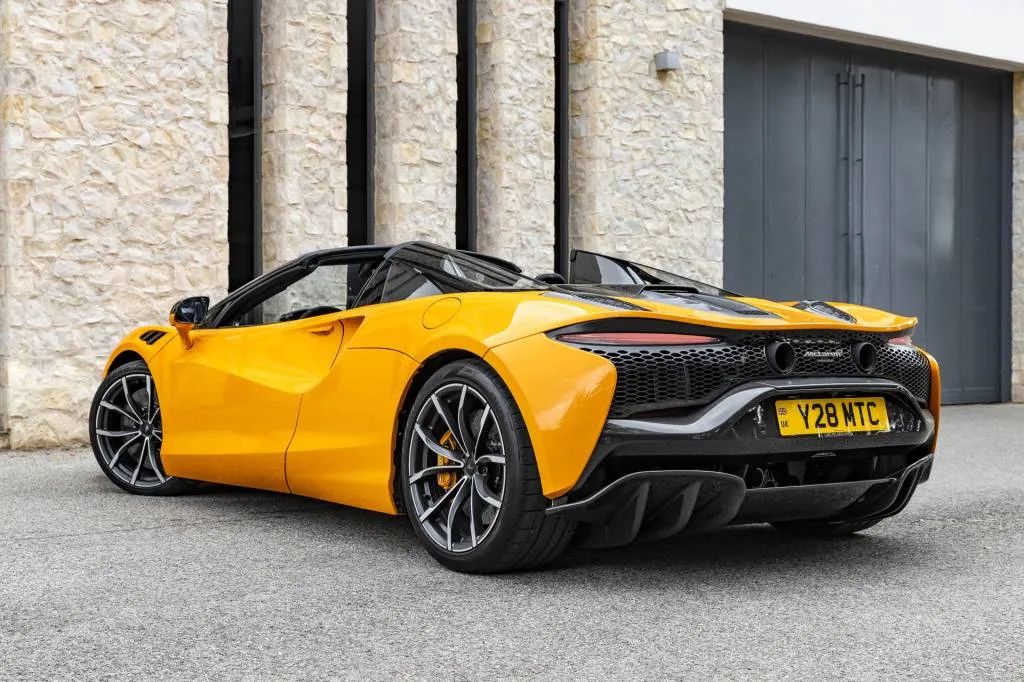
2025 McLaren Artura Spider
Artura features functional race car design
Pretty isn’t a prerequisite for supercars, and neither is angry, but they have to be distinctive. The Artura is, and it’s functional to boot.
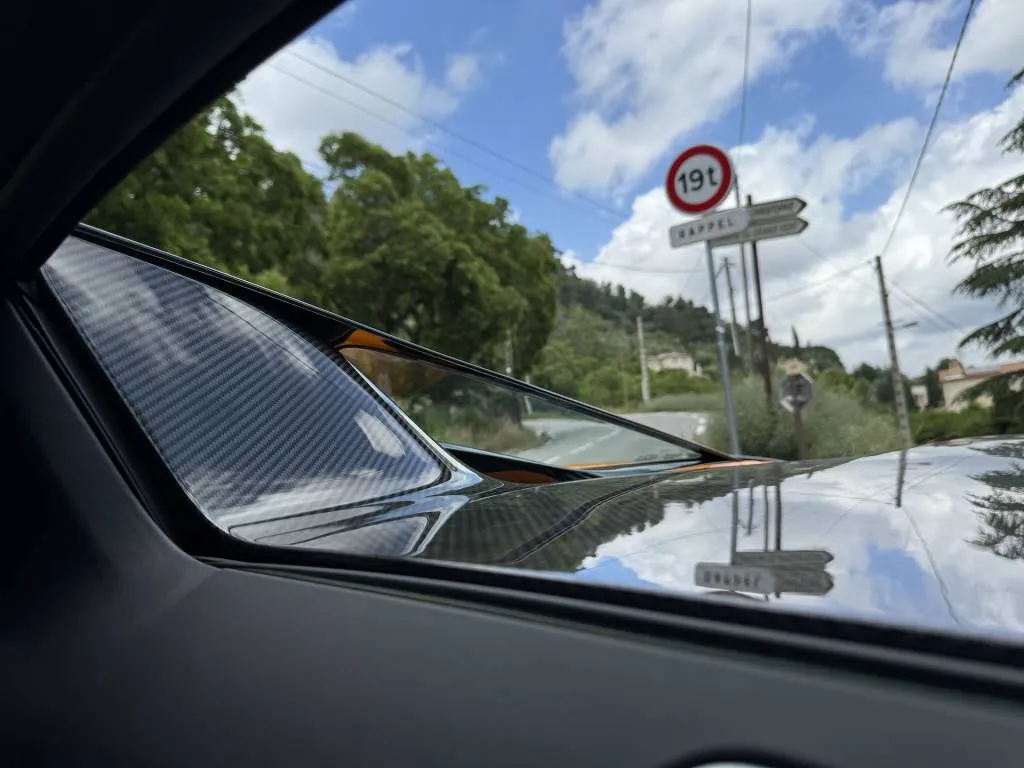
2025 McLaren Artura Spider
All those swoops and inlets are real. They house radiators and ducts that feed this plug-in powertrain and keep everything cool. The front ducts below the headlights feed the low-temp radiators for the battery. The side ducts just behind the doors feed the high-temp radiators for the engine. The clear glazed polycarbonate buttresses behind the cabin hide ducts that shove air into the rear end to deliver low pressure above the hot V of the engine. Vents in the rear decklid above the engine extract this air. The fact that these buttresses are clear is key because if they were solid they would block the view to the rear. But they’re clear and I can see through them.
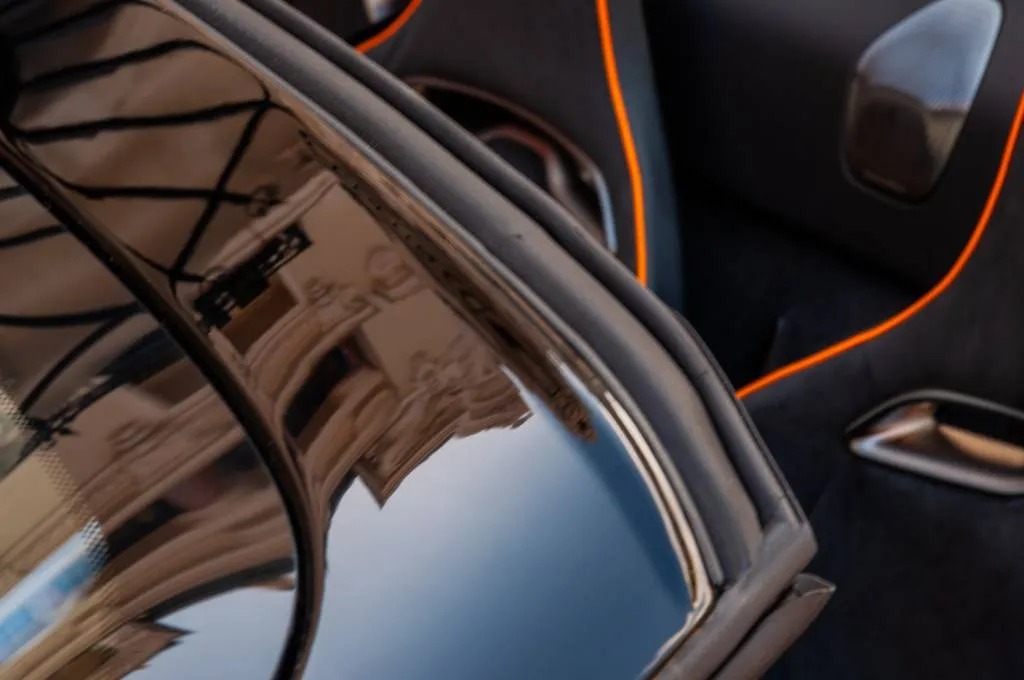
2025 McLaren Artura Spider
At speed with the top down the cabin is calm, even with the windows lowered. A lot of it has to do with a simple little gurney flap that’s integrated into the windshield header.
The design is both more delicate and angrier looking than the 600-series this car supersedes. Those all looked a bit sad and droopy comparatively. The streets of Monaco boast everything from Mercedes McLaren SLRs to various Ferraris, and yet many people are whipping out their phones and snapping photos and videos of me in the McLaren. I assure you, it’s not me, it’s the McLaren.
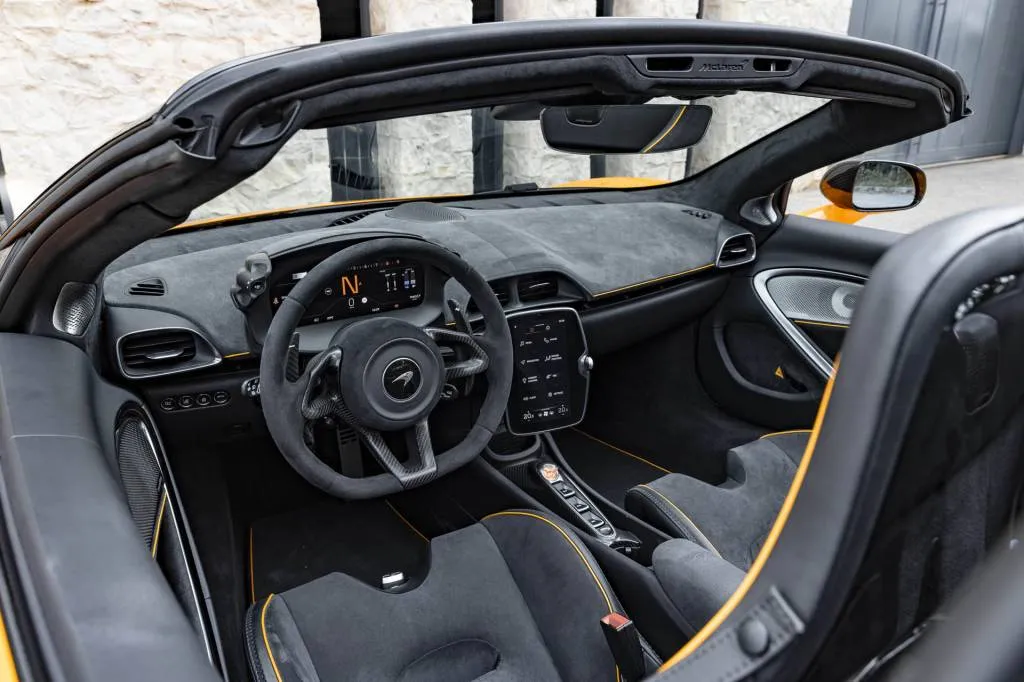
2025 McLaren Artura Spider
Inside, it’s standard Artura fare with a 10.3-inch digital gauge cluster and an 8.0-inch portrait-style touchscreen infotainment system. A volume knob also serves as the home and back button, but that’s about the extent of it. The climate controls on the touchscreen show a person on each side wearing a helmet because this company makes race cars. This is a driver-focused area, yet the clubsport seats are road-trip comfortable. The new upright wireless smartphone charger is somewhat hard to get to as it’s mounted below and behind the touchscreen. It’s also useless if you want to use Apple CarPlay or Android Auto because these aren’t wireless in the Artura, and the USB hookups are in the center armrest. No one said this car was 100% practical, though the front trunk will hold a decent 5.7 cubic feet of stuff.
Two buttons above the rearview mirror control the roof and rear glass. That roof goes up or down in 11 seconds while driving at speeds of up to 30 mph. It’s made of a carbon-composite material, but my tester has the electrochromic option, which can be translucent or opaque, blocking up to 95% of UV rays at the touch of a button. The top of my head is thankful for this feature by lunchtime, though I still get sunburned. Eight electric motors perform the open and closing dance instead of a hydraulic system.
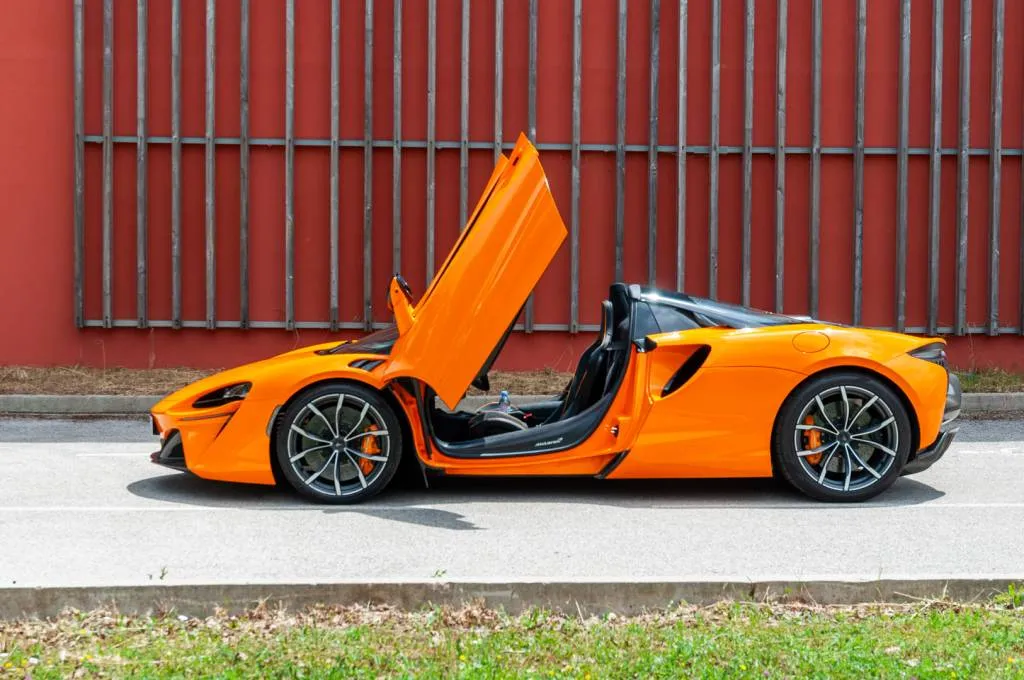
2025 McLaren Artura Spider
Artura Spider value proposition
The Artura Spider starts at $281,008 including the mandatory $5,000 destination charge and $2,208 America Accessories Pack. That last bit is forced upon customers and includes everything from an indoor car cover and hibernation tire cradles to a battery tender and license plate frame.
McLaren prices the Artura Spider right on top of the Maserati MC20 Cielo and more than $50,000 below the Ferrari 296 GTB. The former has less power and no hybrid system, yet weighs nearly the same. The latter is similar in most regards but doesn’t have a carbon-fiber tub. For those looking at the 750S Spider across the showroom, the Artura Spider shaves $91,232 off the price of its bigger brother.
These are all base prices for the peasant-spec cars. Does anyone buy those? The well optioned Artura Spider I’m driving checks in at $374,158 thanks to everything from an $18,450 underbody carbon-fiber package and $4,650 for satin carbon extended sill finishers to $4,950 10-spoke super light dynamo forged wheels.
The 2025 McLaren Spider’s price proposition is a $24,700 premium over the 2025 Artura coupe, but with a hard top, you get two cars in one. That’s a value, no? But option the sport exhaust, and think of McLaren race cars as you listen to it because some of that DNA has trickled down to the Artura.
McLaren paid for travel and lodging for your Motor Authority editor to get sunburned and bring you this first-hand review.
